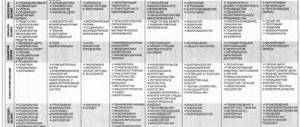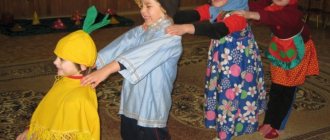Parent meeting on the topic “How to overcome the crisis of three years”
Vologda Region,
Cherepovets
MBDOU "Kindergarten No. 26"
M.Yu. Konnova, educational psychologist
Meeting with parents Topic: “How to overcome the crisis of three years”
The third year of a child’s life... It seems that the hardest part is over, the child has matured and become more independent, but many parents have no idea that the end of early childhood is one of the most difficult periods in the life of both a child and an adult. The child increasingly says: “I myself,” “I want,” etc., increasingly throws tantrums, rebels against others, and tries to get his way by any means necessary. This behavior often upsets, worries and baffles even the most caring parents.
“What is happening to the child? Did we really raise him badly? How to make him be obedient? — these are the questions parents increasingly ask themselves when their child reaches 3 years of age.
Since not every parent knows that the crisis of 3 years is not just another age stage, but a stage at which the formation of new qualities and a restructuring of the child’s personality occurs. And the further emotional and personal development of the baby depends on how painlessly it passes.
Therefore, the problem of the development and education of 3-year-old children is relevant in the conditions of both preschool and family education. And it requires a joint decision on the part of both the teacher and the parent.
TARGET
:
update the problems of education and development of 3-year-old children and find ways to solve them;
TASKS:
*involve parents in an exchange of opinions on issues of relevance to them regarding relationships with their 3-year-old child;
* outline ways and means of overcoming the child’s 3rd summer crisis.
*bring together the parent team;
* replenish parents' arsenal of knowledge on a specific issue.
PARTICIPANTS
:
educational psychologist, educator, parents.
PRELIMINARY WORK:
Educators:
- Written invitations are given to parents two days before the meeting so that they can plan their participation in the meeting in advance.
| INVITATION If you begin to notice that things are not going well with your child, Then hurry up and come to us - we’ll try to find the answer. We will tell you, we will tell you how to overcome whims, How to make friends with a child, how to praise and how to scold! Dear ___________________________ ___ ! If you are interested in the above problems and want to share your experience of family education, we invite you to a parent meeting on the topic: “ How to overcome the 3-year-old crisis” which will take place Teachers of group no. |
2. Multi-colored strips of colored paper are prepared for each parent
(red, yellow, green, orange, purple, black).
Educational psychologist:
1. Prepares a poster with the image of a seven-pointed star
2. Provides advisory material in the information folder for parents on the topics: “If the baby is naughty...”, “Developmental features of 3-year-old children,” “I am myself,” etc.
3. Develops instructions for parents “Whims: what is hidden behind them?”
DESIGN, EQUIPMENT AND MATERIALS:
The meeting is held in the music room, chairs and tables are arranged in groups so that all participants can clearly see and hear each other. On the tables there are strips of colored paper, pins, pens, pencils or markers, blank sheets of paper, a ball of thread.
A poster with the image of the “Seven-Pointed Star” against the sky is attached to the board.
PROGRESS OF THE MEETING
1.OPENING REMARKS
The teacher opens the meeting with a brief introductory speech to explain the goals and procedure for joint actions of the meeting participants.
Parents sit at tables, divided into groups. The presenter invites everyone to make a business card from colored paper. The color is chosen at will (the color symbolizes the momentary mood). Colors used: red, yellow, orange, green, purple, black.
Presenter: “How would you like to be addressed today and would you feel comfortable with this form of address?” Participants write their first name or their middle name. Made business cards are attached to clothes.
Purpose: to assess the emotional state of the participants at the beginning of the lesson, to note the degree of readiness for cooperation using the color technique of A. Lutoshkin.
Criteria for assessing the mood of parents: if the parent chose a color:
Red, then we can assume that he is now in an enthusiastic, high spirits; yellow - bright, pleasant mood; orange - joyful mood; green - calm mood; purple - anxious, tense mood; black - despondency, complete disappointment, loss of strength.
Parents must introduce themselves and say the name of their child.
2. SPEECH BY A PSYCHOLOGIST.
“Getting used to kindergarten coincides with a crisis moment in the child’s mental development. By the age of three, parents notice serious changes in their child; he becomes stubborn, capricious, and quarrelsome. Many people do not know that at this time a very important mental process takes place for the child - this is the first vivid expression of his “I”, this is his attempt to independently separate from his mother, learn to do things on his own and somehow solve his problems. The three-year crisis is called the “seven star of symptoms.” (the psychologist draws attention to the poster with the image of a seven-pointed star).
1 symptom is pronounced negativism (the desire to do everything the other way around, just because he was asked to do so; with a sharp form of negativism, the child denies everything: “This dress is white,” says the mother, and the child, contrary to the obvious: “No, it’s black” Negativism is an attitude not towards an objective situation, but towards a person.)
Symptom 2 - stubbornness (the child gets his way only because he wanted it)
3-obstinacy (whims for any reason, constant dissatisfaction with everything that an adult offers).
4 - self-will (the child wants to do everything himself).
The other three symptoms are less common:
5- rebellion against others (the child quarrels with everyone, behaves aggressively).
6 - the child devalues the personality of loved ones (says swear words to parents, swings toys, refuses to play with them).
7 - in families with one child, there is a desire for despotic suppression of others. The whole family must satisfy every desire of the little tyrant, otherwise they will face hysterics. If there are several children in a family, this symptom manifests itself in jealousy, aggression, and a demand for constant attention to oneself.
Experts in child psychology, describing the symptoms of this crisis, emphasize that at its center is
the child’s rebellion against authoritarian upbringing , against the previously established system of relations in the family, for the emancipation of his “I ”. The child increasingly says: “I myself,” which indicates a desire for independence , autonomy . During this period, the old qualities of the child’s personality are broken down and new ones emerge.
“Pride in achievements” appears; the child requires approval and praise from an adult. Recognition from others changes the child's feelings - the experience of success or failure. He begins to look at himself through the eyes of another. Parents should not be afraid of the severity of the crisis. This is a clear manifestation of a child’s self-affirmation. And, conversely, external “crisis-free” behavior that creates the illusion of well-being can be deceptive and indicate that no corresponding age-related changes have occurred in the child’s development.
Some features of the manifestation of the crisis of three years
-The period of stubbornness and capriciousness begins at about 18 months.
- As a rule, this phase ends by 3.5-4 years. Occasional bouts of stubbornness in older age are also quite normal.
-The peak of stubbornness occurs at 2.5-3 years of age.
-Boys are more stubborn than girls.
-Girls are capricious more often than boys.
-During a crisis period, attacks of stubbornness occur in children 5 times a day. For some, up to 19 times!
-If children, upon reaching 4 years of age, continue to often be stubborn and capricious, then most likely we are talking about “fixed” stubbornness, hysteria, as convenient ways to manipulate parents. Most often, this is the result of the conciliatory behavior of parents who succumbed to pressure from the child, often for the sake of their peace of mind.
3. “HAVE AN OPINION...”
Each group of parents is offered a card describing a problem situation, and each group develops three ways (strategic, tactical and fantastic) to solve this problem.
Variants of problem situations.
What to do, if…
1. You and your child are in a crowded transport, you do not have the opportunity to seat him, you are holding a heavy bag in your hands, and at this time your baby begins to scream and cry...
2. You are washing the dishes, the child stubbornly insists: “I do it myself,” and you know in advance that he will not do it well, and on top of that, he may break it...
3. Entering the room, you see that all the toys with which the child played are scattered on the floor; persuasion to collect them does not work. You feel your dissatisfaction and tension increasing...
and so on.
4.PRACTICAL ADVICE FROM A PSYCHOLOGIST
“Many parents are tormented by the question: can a parent, acting competently, mitigate the manifestations of a crisis? How to help a child get out of it without enduring negative qualities in his soul: after all, stubbornness is an extreme degree of manifestation of will, a quality necessary for a child; capriciousness - a demonstration of one’s own importance for others, a sense of one’s “I”.
What parents can do:
Do not attach much importance to stubbornness and capriciousness. Take note of the attack, but don't worry too much about the child .
During an attack, stay close to him and let him feel that you understand him.
Do not try to instill anything in your child at this time - it is useless. Swearing is pointless, spanking will excite you even more.
Be persistent in your behavior with your child. If you said no, continue with that opinion.
Don’t give up even when your child has a seizure in a public place. Most often, one thing helps - take him by the hand and lead him away.
Hysteria and capriciousness require an audience, do not resort to the help of strangers: “Look, what a bad girl, ah-ah-ah!” This is all the child needs.
Try to cheat: “Oh, what an interesting toy I have (book, little thing....).
“What is that crow doing there outside the window?” - such distracting maneuvers will intrigue the capricious person, and he will calm down
.”
5. DRAWING
Parents are invited to draw on the topic for 8-10 minutes
“The world of childhood and the world of adults,” and then give an explanation for your drawing.
Questions for parents:
-Is there interaction between the world of adults and the world of children in your drawing?
-How can they interact and help each other?
-What world do you want to be in now?
-What do you think the adults in this picture want to tell the children? What do children want to tell adults?
-Is there a place for conflict in the picture? Where?
Let the parents try to play out the situation of interaction between an adult and a child, which can be resolved in both conflict and non-conflict ways. In the process of playing out the stated situation, it is important to clarify the motives of the child’s behavior and correlate them with the appropriateness of the methods chosen by the parents to regulate the situation.
6.SELF-ASSESSMENT
Meeting participants need to continue the phrase : working with the group, I realized that.....
sample answers:
*By the age of 3, the desire for independence and independence from an adult sharply increases, which finds expression in the crisis of three years.
*This crisis outwardly manifests itself in negativism, stubbornness, and obstinacy.
*By the age of 3, a special behavioral complex arises - “pride in achievements”, which covers all the main areas of the child’s relationship: to the objective world, to other people, to himself.
*A new vision of the Self through the prism of one’s achievements lays the foundation for the rapid development of children’s self-awareness.
*The formation of such a self-system, where the starting point is an achievement appreciated by others, marks the transition to preschool childhood, etc.
7.FINAL STAGE
Reminders are issued to parents as recommendations
Psychologist's advice
- Adults must maintain the child’s overall positive attitude towards himself;
- You should not compare your child’s failures with the successes of others;
-Where possible, give him the right to choose for himself, give him more independence;
- Respect the child’s plans, answer in such a way that the child feels your interest in the matter;
-If you allow your child to achieve a goal with the help of a tantrum, this will become a sustainable form of behavior;
- As soon as the child begins to be capricious, hug him, reassure him of your love and try to distract him from the capriciousness.
- When the child calms down, talk to him gently. Tell him that you are upset by his behavior, express confidence that in the future he will behave better.
- Try to read morals less, set prohibitions, punish and more affection, patience, even at the cost of some compromises.
8.FEEDBACK (reflection)
The ball is passed from participant to participant. When it is in someone’s hands, this person shares his impressions of how he felt at the beginning, during the process and at the final stage of work, and expresses his wishes.
9. A MINUTE OF GRATITUDE.
The teacher thanks the parents for their success in raising children, notes those of them who took an active part in the lesson and shared their experience of family education.
Bibliography
1. Galiguzova L.N., Smirnova E.O. “The art of communicating with a child.” M;-2004.
2. Smirnova E.O. "Child Psychology". M.; 1997.
3. Kryazheva N.L. “Development of the emotional world of children.” Yaroslavl, 1997.
4. Yakovleva N.G. “Psychological assistance to preschoolers.” M.; 2002.





